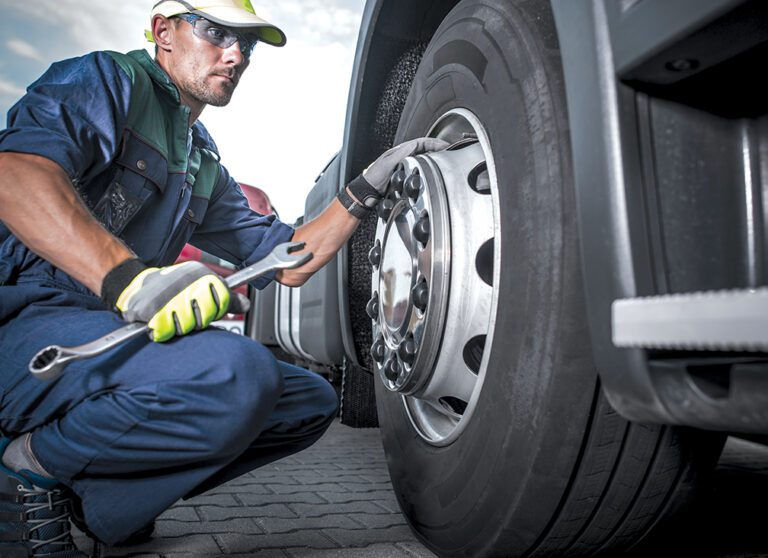Tires are second only to fuel in annual expenses for motor carriers both large and small. With a new set of truck tires costing $2,500 or more — plus the cost of repair and replacement for damage, including road service calls — it’s no wonder tires take up such a large amount of the budget.
Sadly, much of the expense for tire replacement and road service could be avoided with a few simple precautions. Even without service, the service life of the tires on a truck can be extended.
Modern tires are built to run longer, and they provide greater traction and require less fuel to turn than ever before. No matter how new the technology however, improper inflation, overloading and damage from road objects are still tire-killers. In some cases, it happens quickly; in others the damage builds over time, but the result is the same — you need a new tire.
Choosing the right tires is a critical step. Some buyers simply look for the best deal they can find. That’s a great way to ensure that you’ll be looking for another deal sooner than you expected. It’s easy to find reviews and ratings of each brand of tire and its manufacturer on the internet, so do your research.
But before you can choose a tire brand, you’ll need to determine what type of tire you’ll need. If you run heavy loads, you’ll need a tire with a larger weight rating. Do you drive off-road (including dirt or gravel parking lots), or maybe put on a lot of miles in winter weather? A lug type tread pattern might be best for you. On the other hand, if traction is a little less important and higher fuel mileage is your goal, choose a ribbed tire.
Whatever type of tire you need, ask around for brand advice. You’ll find plenty of opinions about which brands last longest, which manufacturers have the best warrantee, and which to avoid altogether.
Once you’ve bought your new tires, inspection and inflation are keys to getting the most from them. A thorough daily inspection is mandatory. Damage can occur that can’t be seen unless you check carefully, including the sidewalls between tandems or inside, next to the frame rails. Sidewall damage can include cuts, punctures and scrapes, as well as bulges (bubbles of air trapped between the sidewall layers). Most sidewall damage will eventually cause the tire to fail, which could lead to damage to your truck or even an accident if the failure happens at a critical moment.
Check the tread, too. Drivers and tire technicians are often amazed at the objects that get stuck in tire treads. Nails and screws are common, but objects such as cigarette lighters, table forks, keys and more have worked their way into tire treads. Inspect the tread often, removing any foreign objects found as soon as possible. Timing is important, because objects can work their way into the tire interior over time, so an object that hasn’t created a puncture at the moment could be the cause of a flat tire later.
When examining objects lodged in the tread, listen for air leaks. If there’s any doubt about a leak, a simple cup of water can be very revealing. Pour the water on the object or the tread around it and watch for bubbles. Even a tiny leak will cause some bubbling.
If a leak is found, get it repaired as soon as you can. The longer you wait, the more damage will be done.
When it comes to inflation, many drivers never go farther than using a hammer, a tire “thumper” or a boot to determine inflation. True, whacking a tire is a good way to tell if it’s inflated or flat — but it doesn’t provide a good estimate of the inflation level. Inflation level can be critical.
In a tandem setup, for example, just a few pounds difference in the inflation of two side-by-side tires can have catastrophic results. If one tire is lower than the other, the tire with the greater inflation takes on more weight. This causes heat to build up, which can result in a blowout. That heat can also damage the internal wrappings of the tire, so the blowout may not occur today … but it very well might later.
The underinflated tire bears less weight but generates more heat because of the continual flexing of the tread as it rotates. Heat destroys tires. In some cases, the overloaded tire fails, but it may do so without blowing out. The driver may not hear the failure; meantime, the remaining tire in the tandem is now supporting the weight previously held by two tires. Eventually, it too will fail. That’s likely the scenario when you spot a truck on the side of the road with two blown tires on the same axle.
Every driver should have — and use — a quality tire gauge to measure tire pressure in each tire on the vehicle. Pressure changes when tires heat up, so check them before starting out, when possible. Remember that the sun shining on tires can add a few pounds of pressure by heating the air inside, so don’t make adjustments based on the initial measurement alone.
It’s a good idea to carry an air hose that attaches to the emergency tractor glad-hand. Such a setup can be used to fill tires anywhere the truck engine can be run. The hose can also be used to blow dust and dirt from the radiator or to power polishers, grinders and other pneumatic equipment.
Finally, tire inspection should be ongoing, because damage can occur at any time. Make it a habit to look at the tires when you stop. For example, you can inspect the tires on one side of the truck and trailer while walking to the restroom, then the other side while walking back. This is where use of a tire thumper helps in identifying a tire that’s low or flat. After driving through an area with debris or any rough surface, it’s best to inspect again.
Take good care of your tires and they’ll take good care of you.
Cliff Abbott is an experienced commercial vehicle driver and owner-operator who still holds a CDL in his home state of Alabama. In nearly 40 years in trucking, he’s been an instructor and trainer and has managed safety and recruiting operations for several carriers. Having never lost his love of the road, Cliff has written a book and hundreds of songs and has been writing for The Trucker for more than a decade.








